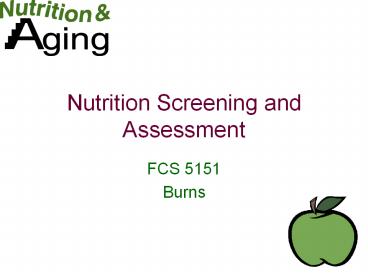Nutrition Screening and Assessment - PowerPoint PPT Presentation
1 / 26
Title:
Nutrition Screening and Assessment
Description:
Differentiate between nutrition screening and assessment ... Hair, eyes, lips, gums, mouth, tongue, teeth, face, neck, nails, skin. More subjective ... – PowerPoint PPT presentation
Number of Views:1540
Avg rating:3.0/5.0
Title: Nutrition Screening and Assessment
1
Nutrition Screening and Assessment
- FCS 5151
- Burns
2
Session Outcomes
- Differentiate between nutrition screening and
assessment - Analyze the nutritional status of a classmate
using a variety of screening and assessment tools.
3
Nutrition Screening
- Process of identifying characteristics known to
be associated with nutrition problems - Purpose to quickly identify persons at greatest
risk for malnutrition, especially protein energy
malnutrition (PEM) - Quick, safe, and cheap
4
Types of Malnutrition
- Protein-energy malnutrition
- Acute vs. chronic
- Kwashiorkor protein deficiency
- Marasmus energy deficiency
5
Kwashiorkor v marasmus
6
Identifying characteristics
- Kwashiorkor
- Edema
- Less obvious muscle wasting
- Mental changes
- Poor appetite
- Fatty liver
- Marasmus
- Severe wasting of muscle and fat
- Good appetite
- No mental changes
- Minimal changes in hair color/texture
7
Nutrition Screening
- What it is?
- Who does it?
- When it is done?
- Where?
- How?
8
From the video
- Characteristics of malnutrition
- Parts/steps of screening
- Outcomes of screening
9
Nutrition Screening Process
- Includes a quick collection and interpretation of
crucial data - Determines the need for nutritional assessment
- Identifies level of risk for malnutrition through
the examination of many risk factors
10
Nutrition Screening Initiative (NSI)
- Focuses on older Americans
- Joint effort
- Goals
- ID potential risk factors
- ID indicators of malnutrition
- Raise public awareness
11
Nutrition Assessment
- Comprehensive approach that defines nutritional
status using medical, nutrition, and medication
histories physical examination anthropometric
measurements and laboratory data. - Process of estimating individual or group
nutritional status as a basis for - identifying needs and goals
- planning personal health care
- community programs to meet nutritional needs
12
Assessing Nutritional Status
- Anthropometrics
- Biochemical
- Clinical
- Dietary
- Emotional
- Functional
- Medication
13
Anthropometric methods
- Measurements of physical dimensions and gross
composition of body - Commonly used
- Specific measures include height, weight,
skinfolds, BMI, waist circumference
14
Biochemical methods
- Measurements of chemical components
- Provide indications of tissue level and/or
functioning - Most objective, but expensive and invasive
- Examples?
- Factoring influencing values
15
Factors Influencing Lab Values
- Hydration status
- Physiological stress
- Sensitivity of the test
- Blood being tested
- Sensitivity of the equipment
- Validity of reference standards
16
Clinical assessment
- Observation of physical signs associated with
malnutrition - Hair, eyes, lips, gums, mouth, tongue, teeth,
face, neck, nails, skin - More subjective
- Very useful in screening
17
Dietary assessment
- collection of food intake data
- analysis and interpretation of food intake data
- to make judgments about dietary adequacy
- can occur at the national, household, or
individual level
18
Dietary Assessment Types
- Food records
- Estimation by recall
- Food frequency
- Diet history
- Direct observation
19
Emotional Assessment
- Why important to include?
- What kinds of questions are asked?
20
Functional Assessment
- Activities of daily living
- Self-care activities
- Instrumental activities of daily living
- Those that require a higher level of functioning
21
(No Transcript)
22
(No Transcript)
23
Medication Assessment
- Drug-drug and drug-nutrient interactions
- Inhibit absorption of nutrients
- Increase the excretion of a nutrient
- Cause nausea, vomiting, diarrhea
- Inhibit or induce metabolism of a nutrient
- Increase or decrease appetite
- Alter the taste and smell of the individual
24
What do you think?
- What are the top five commonly used medications
in men and women aged 65?
25
Issues of data collection
- Validity
- Reliability
- Cultural issues
26
Session Assessment
- Differentiate between nutrition screening and
assessment - Analyze the nutritional status of a classmate
using a variety of screening and assessment tools.

